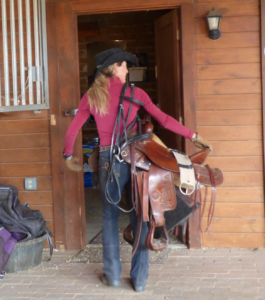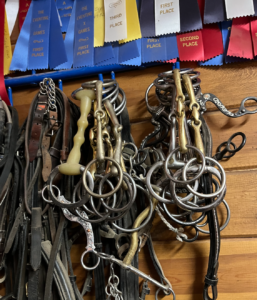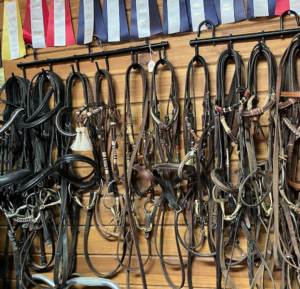 Editor’s Note: Best Horse Practices Summit presenter Katrin Silva grew up riding dressage in Germany before moving to the United States at age 19 to learn to ride Western. She’s been riding both disciplines for the last 20 years and is a regular guest columnist for Cayuse Communications. The author of Dressage for All of Us: How to Help Any Horse Become a Happier, More Responsive Riding Partner and the forthcoming Ride with Feel: A Guide for the Rest of Us lives in New Mexico where she works with dressage and Western clients.
Editor’s Note: Best Horse Practices Summit presenter Katrin Silva grew up riding dressage in Germany before moving to the United States at age 19 to learn to ride Western. She’s been riding both disciplines for the last 20 years and is a regular guest columnist for Cayuse Communications. The author of Dressage for All of Us: How to Help Any Horse Become a Happier, More Responsive Riding Partner and the forthcoming Ride with Feel: A Guide for the Rest of Us lives in New Mexico where she works with dressage and Western clients.
Katrin Silva writes:
My tack room is stuffed with, well, stuff. Over the years, I’ve accumulated a collection of dressage and Western saddles, saddle pads, half pads, dressage girths and Western cinches. The walls are covered with bridles. I own a few Western curb bits, a couple of double bridles, and a couple of bitless bridles, but most of my dressage and Western headstalls have snaffle bits attached to them.
I’ve lost count of how many snaffle bits I own: single jointed, double jointed, loose ring and eggbutt. Some thick, some slightly thinner. Sweet iron, stainless steel, various alloys, copper, and titanium. Other women buy shoes. I buy snaffle bits.
 The thrill of trying a new snaffle is worth the expense, I tell myself. At the same time, I know the new bit won’t make me a better horsewoman. It may help me communicate with a horse a tiny bit better, but that’s it. A new bit, though is not a magic bullet, I remind myself.
The thrill of trying a new snaffle is worth the expense, I tell myself. At the same time, I know the new bit won’t make me a better horsewoman. It may help me communicate with a horse a tiny bit better, but that’s it. A new bit, though is not a magic bullet, I remind myself.
It’s tempting to think that a piece of equipment will fix all our horse’s issues:
- Using a rope halter instead of a nylon one will drastically improve our horse’s ground manners.
- Switching to a different bit, or a bitless bridle, will teach our horse lightness overnight.
Of course, we should choose tack that allows for the best possible communication between us and our horses. And we should never use equipment that hurts our horses, either because it doesn’t fit or because it’s designed to cause pain. Horses can’t listen when a saddle pinches their back, when a tight flash noseband clenches their jaw shut, or when a twisted wire bit cuts into the corners of their mouth.
Interested in learning more about the horse’s mouth? Check out Daniel Dauphin’s presentation at the Best Horse Practices Summit.
But, in and of itself, even the best equipment won’t make horses fitter, straighter, more balanced, or more responsive to our aids, for two reasons:
The tools we use won’t do the work for us.
 We still have to learn how to use them correctly. Inexperienced riders underestimate how long this takes. I have a ton of respect for the California bridle horse tradition, with its bosals and spade bits. These are great tools, but using them the way they’re meant to be used takes practice – not a weekend clinic’s worth of practice, or even ten clinics’ worth of practice, but years. Decades, even. There is no substitute for riding different horses at different stages of training, in the bosal, in the two-rein, in the spade bit, under the guidance of an expert mentor who offers timely, constructive feedback.
We still have to learn how to use them correctly. Inexperienced riders underestimate how long this takes. I have a ton of respect for the California bridle horse tradition, with its bosals and spade bits. These are great tools, but using them the way they’re meant to be used takes practice – not a weekend clinic’s worth of practice, or even ten clinics’ worth of practice, but years. Decades, even. There is no substitute for riding different horses at different stages of training, in the bosal, in the two-rein, in the spade bit, under the guidance of an expert mentor who offers timely, constructive feedback.
I have started a few horses in bosals and know the basics of hackamore riding, but I’ve never spent the time to get good at using one. (I grew up in Germany, in the 1980s, when Western-style riding was a novelty in Europe.)
Dressage is the riding tradition I grew up in and have spent my entire life studying. Because of this, snaffle bits are my bit of choice. After spending years riding eight or more horses a day, six days a week, mostly in snaffle bits, and after so many lessons and clinics taken, I feel I’m getting good at using them. I consider this learning a worthy life goal.
The tack we choose is not as important as overall good horsemanship.
There is no shortcut to a balanced, centered, effective seat and independent hands. There is no shortcut to quiet confidence and slow movements, and to feel and impeccable timing.
How do we get there?
- By riding many different horses.
- By riding a lot.
- By working with expert mentors on a regular basis.
- By making lots of mistakes, and learning from them.
- By cultivating patience.
- By studying the theory of horsemanship.
- By hanging in there, instead of getting discouraged and giving up.
- By keeping a sense of humor.
Watching great riders is inspiring – in any type of saddle, in any type of bridle with nearly any kind of bit. We can achieve harmony between horse and rider, when we learn to recognize and admire it in others. Imitation is part of that learning process.
So, it’s tempting to buy the same stuff used by our role models, in the hope of re-creating what they do with horses. But the stuff is not their set of qualities: trust, confidence, awareness, body control, knowledge, empathy, and a calm way of being around horses. That stuff is not for sale.
Interested in learning more about the horse’s mouth? Check out Daniel Dauphin’s presentation at the Best Horse Practices Summit.